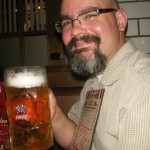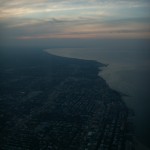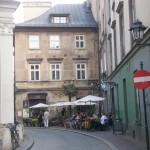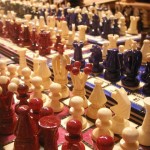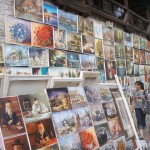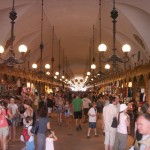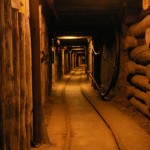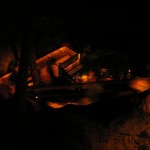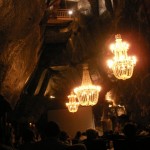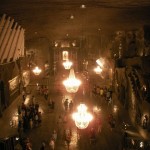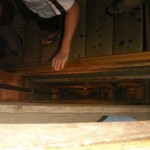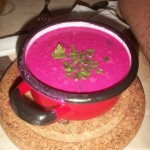Way back in July, before Jaialdi, I went to Poland for the Computer Simulations of Radiation Effects in Solids (COSIRES) conference, held in Krakow (previous hosts of this conference have included Beijing, Richland WA, and Helsinki). Thoughts on my trip (that I can remember… I really need to write these down when I’m there):
- As I do more and more travel, I’m trying more and more to keep my trips shorter, both to help my family out as my wife works on the weekends, but also to see them more and minimize the time away from home. So, I flew out late on a Saturday and returned on a Friday. The flight passed over Chicago, hence the one photo. This doesn’t leave a whole lot of time to see any sights, but fortunately COSIRES had an excursion that let me see a little.
- Krakow is a nice older European city. It supposedly sports the largest plaza of any city in Europe, or so I was told. It has a majestic Cathedral in the center of the plaza, which we were going to check out until we learned that if you are just a tourist (and not there for prayer) they charge a fee to enter. Having seen a lot of Cathedrals in Europe, I didn’t feel like paying the fee. We did check out their big indoor market, which had lots of stalls selling a bit of everything, but mostly things geared toward tourists: jewelry, clothes, scarfs, and such. There were a number of shops selling wooden toys, presumably hand made, and I got my daughter a wooden train. And a ceramic bowl for my wife (I guess Poland is known for their ceramics?). There were a lot of chess sets on sale too, for extremely cheap prices (a whole set that was reasonably sized — maybe 15 inches square — cost something like $15-20).
- The only other thing I saw was during the conference excursion. They took us to an old salt mine — the Wieliczka Salt Mine, which is a UNESCO World Heritage Site — that has since been turned into a tourist attraction. Which might sound a bit odd, but it was actually very interesting. We climbed down wooden stairs that took us something like 150 meters or roughly 450 ft below the surface. Overall, we ended up something like 300-400 meters underneath, maybe a bit over 1000 ft. The place was amazing. Lots of caverns and tunnels winding all around. There are little displays showing how work and life was in the mine (which was a bit hokey, but ok). The interesting thing is what they carved into the mountain. There were chapels for worship, statues depicting various scenes (carved out of the salt), and big halls for entertaining and such. There was a room/cavern dedicated to Copernicus, who I guess was heavily involved in mining at the time (besides being a very important astronomer). As we wandered, we could see little particles floating in the air, which I think were just large water drops, large enough to see but small enough to float, with salt dissolved in them. The conference dinner was held in a hall in the mine, which was done to look still a bit rough. It was pretty neat to be dining deep underground like that.
- The conference itself was good, with some nice discussions and possible new collaborations. The organizers did a nice job and the setting, at one of the university buildings, was very nice. I pitched that we host the next one in 2012 in Santa Fe and that pitch was accepted. So, work to be done.
- I was able to sample a little of the local cuisine. Being a carnivore, I focused on things like schnitzel which was very good. Some things looked a bit odd, such as a bright pink soup that just struck me as an odd color for any food.
